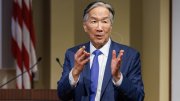Glimp professor of economics Edward L. Glaeser, who directs the Rappaport Institute for Greater Boston, has been using the Boston Globe as a forum for critiquing government policies; in Sunday's Ideas section, he took aim at the tax deduction for mortgage interest.
He writes:
The tax subsidy does modestly encourage homeownership. But it specifically encourages borrowing to invest in expensive homes, which are risky assets that can crash as well as boom.
The federal government would do better to enact a tax credit specific to first-time homebuyers, in a set amount that does not vary according to the home's value, and do away with the current policy, which rewards larger mortgages with a larger deduction and does not distinguish between a homeowner's first home and his seventh, he writes.
The current policy was enacted in the 1940s as part of the New Deal, and it made sense in a time when 45 percent of American homes lacked indoor plumbing and more than 20 percent of homes had more than one person per room, Glaeser writes. But he believes the policy has outlived its usefulness:
By 1980, less than 3 percent of homes lacked plumbing and less than 5 percent had more than one person per room. Today, the average American has close to 1,000 square feet of living space, more than twice the norm in France or England or Germany.
Any policy that props up lending will be popular with voters who are already homeowners, because such policies make it easier for people to buy and therefore prop up prices, Glaeser writes. But he questions how much such policies can do to keep prices from plummeting as the bubble bursts. And he takes aim at the notion that owning is always better than renting:
As recent events well illustrate, owning a home comes with large risks, especially for people who aren't planning on living in the same place for a long time. For people who live in multifamily dwellings, the administrative costs of renting can be much lower than dealing with the difficulties of collective ownership. Renting creates more flexibility for people in America's highly mobile workforce. A far more sensible approach to housing would view homeownership as one possible housing option, not a primary public goal.
Read the full essay here. For more by Glaeser, click here to read his critique of a proposed tax credit for home heating costs.








